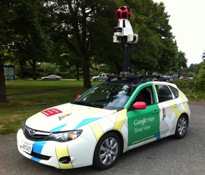What the Heck Is Drawbridge?
 You won’t find out from this New York Times front-page story from yesterday, which is disappointingly long on alarmism but scarce on details, a phenomenon all too frequent in privacy reporting. In the third sentence — immediately after anthropomorphizing smartphones — the story tells us that “advertisers, and tech companies like Google and Facebook, are finding new, sophisticated ways to track people on their phones and reach them with individualized, hypertargeted ads.” Boy, that sounds bad — exactly what horrible new thing have they come up with now?
You won’t find out from this New York Times front-page story from yesterday, which is disappointingly long on alarmism but scarce on details, a phenomenon all too frequent in privacy reporting. In the third sentence — immediately after anthropomorphizing smartphones — the story tells us that “advertisers, and tech companies like Google and Facebook, are finding new, sophisticated ways to track people on their phones and reach them with individualized, hypertargeted ads.” Boy, that sounds bad — exactly what horrible new thing have they come up with now?
The third paragraph tells us only what privacy advocates fear. The fourth mentions the National Security Agency. The fifth quotes privacy scholar Jennifer King saying that consumers don’t understand ad tracking.
The sixth paragraph finally gives us a specific example of the “new, sophisticated ways” advertisers and tech companies are “track[ing] people on their phones”: Drawbridge. What does Drawbridge do? It’s “figured out how to follow people without cookies, and to determine that a cellphone, work computer, home computer and tablet belong to the same person, even if the devices are in no way connected.” But this doesn’t tell us much. There are more and less innocuous ways to accomplish the goal of tracking users across devices. On the innocent end of the scale, a website could make you sign into an account, which would allow it to tell who you are, no matter what computer you use. On the malevolent end of the scale, it could hack into your devices and access personal information that is then linked to your activity. The key question is, how is Drawbridge getting the data it is using to track users, and what is in that data?Read More »What the Heck Is Drawbridge?
 I do intend to get back to my four-part series on whether Google’s collection of information from residential Wi-Fi networks violated the Wiretap Act. That issue is being litigated in the Northern District of California in a consolidated class action of home wireless network users, and the earlier posts in my series examined the plaintiffs’, Google’s, and the district court’s arguments on this issue. See
I do intend to get back to my four-part series on whether Google’s collection of information from residential Wi-Fi networks violated the Wiretap Act. That issue is being litigated in the Northern District of California in a consolidated class action of home wireless network users, and the earlier posts in my series examined the plaintiffs’, Google’s, and the district court’s arguments on this issue. See  Time, and the Ninth Circuit, wait for no man. You may recall that I was halfway through my four-part series on the arguments in Joffe v. Google, the “Wi-Spy” case in which Google’s Street View cars intercepted and stored data captured from residential wireless networks. Google argued that that activity did not violate the Wiretap Act, because the Wiretap Act does not apply at all to Wi-Fi. There’s an exception in the Wiretap Act for “electronic communications readily accessible to the general public,” and the Act defines “readily accessible” for “radio communications” to mean that the communications must be encrypted or otherwise protected. Wi-Fi is broadcast over radio, and the plaintiffs did not set up encryption. Here’s
Time, and the Ninth Circuit, wait for no man. You may recall that I was halfway through my four-part series on the arguments in Joffe v. Google, the “Wi-Spy” case in which Google’s Street View cars intercepted and stored data captured from residential wireless networks. Google argued that that activity did not violate the Wiretap Act, because the Wiretap Act does not apply at all to Wi-Fi. There’s an exception in the Wiretap Act for “electronic communications readily accessible to the general public,” and the Act defines “readily accessible” for “radio communications” to mean that the communications must be encrypted or otherwise protected. Wi-Fi is broadcast over radio, and the plaintiffs did not set up encryption. Here’s  (This is Part 2 of 4 posts on the issue of whether the Wiretap Act bars interception of unencrypted wi-fi signals. See
(This is Part 2 of 4 posts on the issue of whether the Wiretap Act bars interception of unencrypted wi-fi signals. See